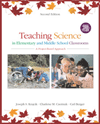| content knowledge | The central concepts, principles, and theories in an area of study.
|
 |
 |
 |
| digital cameras | Cameras that take pictures in digital format and can be used as a data collection device by students.
|
 |
 |
 |
| digital divide | Lack of technology access by needy and at-risk students.
|
 |
 |
 |
| digital libraries | Various documents saved in digital format that can be accessed through the World Wide Web.
|
 |
 |
 |
| interactive multimedia | Technologies that combines video, pictures, graphics, and text in an interactive manner to present information.
|
 |
 |
 |
| learning technologies | The use of computers, software, and various peripherals that support students in learning.
|
 |
 |
 |
| metacognitive knowledge | Having knowledge about cognition in general, as well as awareness and knowledge about one's own cognition.
|
 |
 |
 |
| microcomputer-based laboratories (mbls) | Software and probes that allow students to collect various types of data in real time.
|
 |
 |
 |
| microworlds | Software that combines video, pictures, computer graphics, ext, and interactivity to present to students situations that otherwise would be inaccessible or too hazardous, time-consuming, or expensive for students to explore.
|
 |
 |
 |
| models | Simplified representations of natural phenomenon.
|
 |
 |
 |
| multiple representations | Ideas expressed in more than one media including text, graphics, images, and video.
|
 |
 |
 |
| primary data sources | Data sources developed and used by scientists.
|
 |
 |
 |
| probes | Electronic instruments connected to computers that allow or the collection of data including temperature, force, motion, and pH.
|
 |
 |
 |
| procedural knowledge | Knowledge to find solutions to questions, to design an experiment, and to find and evaluate background information related to a question.
|
 |
 |
 |
| real-time graphs | Graphs generated in real time by computer software as students collect software using probes.
|
 |
 |
 |
| simulations | Software that allows students to explore what it might be like to manipulate variables that would otherwise be just too difficult, impossible, or unethical to do in the real world.
|
 |
 |
 |
| telecommunication | Students use the World Wide Web to communicate with other students in remote or distance areas.
|
 |
 |
 |
| video camera | A camera that records onto digital or videotape.
|
 |
 |
 |
| visualization tools | Technology tools that enable students to "see", explore, and analyze scientific data.
|



 2003 McGraw-Hill Higher Education
2003 McGraw-Hill Higher Education